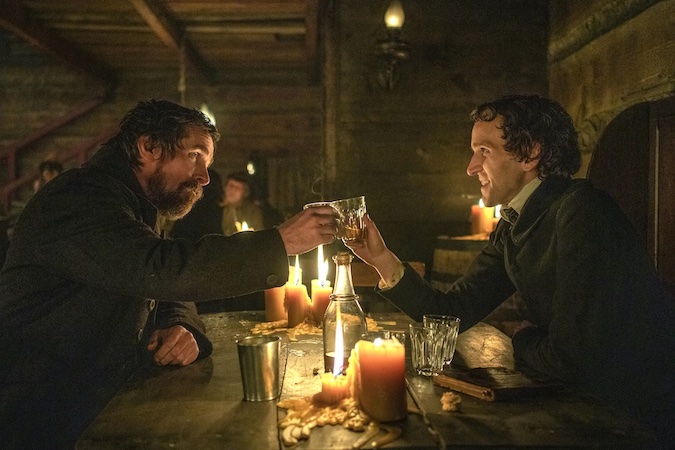
About 88 minutes into The Pale Blue Eye, Edgar Allen Poe (Harry Melling) recites a poem for his beloved, Lea (Lucy Boynton) that he says came to him while he slept. It concerns a woman named “Lenore” caught in “endless night” — “shrouding all but her pale blue eye.”
The real Lea suffers from intense seizures, and Poe tells her that the endless night of his poem refers to her “unspeakable distress.” He also makes clear that the name “Lenore” is a substitute for “Lea.” The poem was made up for The Pale Blue Eye, but it contains elements of real Poe poems, notably “Lenore” and Poe’s most famous poem of all, “The Raven.” The “pale blue eye,” meanwhile, references what is arguably Poe’s most famous story, “The Tell-Tale Heart.”
Though The Pale Blue Eye is fiction — it’s written and directed by Scott Cooper and based on the novel of the same name by Louis Bayard — the film is based on events in Poe’s real life, and delights in obscure literary allusions. For example, Christian Bale, who plays investigator Augustus Landor, has told MovieMaker that he believes his character is named for a detective in Poe’s story “The Purloined Letter.”
The Pale Blue Eye invites us to imagine that the young Poe we meet in the film in 1830 will remember its (made-up) events for the rest of his life, and incorporate them into his work. The film subtly and brilliantly reverse engineers its story around some of the greatest mysteries of Poe’s work, such as the identity of Lenore, as referenced in “Lenore,” and “The Raven.” The film cleverly twists the meanings of stories and poems we likely read in high school to imagine them from the perspective not of the real Edgar Allen Poe, but of the fictional Edgar Allen Poe played by Harry Melling.

This fictional Poe, of course, would be especially haunted (hark! major spoilers follow!) by the death of his first love, Lea, who we see perish in a bizarre and tragic accident during an attempted occult bloodletting ritual and subsequent fire. He is no doubt also troubled by his decision to let Landor posthumously frame her and her brother for two murders.
It’s interesting to ponder how this Poe would have gone from appreciating the dreamy pale blue eyes of his Lenore to the grotesque pale blue eye of the murdered man in “The Tell-Tale Heart,” the only writing of Poe’s that seems to reference a pale blue eye. “The Tell-Tale Heart,” as we may remember from ninth grade, is about a man who is haunted by the perhaps-imagined sound of a still-beating heart of a man he has murdered. (“One of his eyes resembled that of a vulture — a pale blue eye, with a film over it,” the real Poe wrote.) The character in the story is haunted by a tell-tale heart; the Poe who let Lea be framed must be haunted by tell-tale heartache.
The film spells out that the Lenore of “Lenore” is inspired by the Lea of the film, but the sadness of this is more acute when you consider that “Lenore” was first published in 1831, one year after the events of the film. We can imagine the Poe in the story, fresh with grief and shame over his sullying of Lea’s name, writing the rather overwrought “Lenore” as a kind of apology and exorcism.
“A saintly soul floats on the Stygian river” the real Poe wrote in “Lenore.” The poem continues: “Come! let the burial rite be read — the funeral song be sung! An anthem for the queenliest dead that ever died so young — a dirge for her the doubly dead in that she died so young.” It also laments “the dear child that should have been thy bride.”
We can also imagine an older, more detached Poe, 14 years later, still thinking of Lea as he again referenced Lenore in “The Raven.” This poem, a masterpiece of goth musicality, is the work of a cooler Poe, perhaps having a bit of dark fun with all the melodrama — or pitch-black broken by all the loss and regret. With hypnotic repetition, “The Raven” laments the loss of the “rare and radiant maiden whom the angels name Lenore.” The raven of the title enters the narrator’s room and perches on a bust of Pallas, a young girl in Greek mythology who dies because of a man’s miscalculation. It’s not hard to see parallels between her and Lea in The Pale Blue Eye.
Some scholars contend that the “Lenore” of the Raven refers to Poe’s real-life wife (and cousin) Virginia, who suffered from tuberculosis as Poe wrote “The Raven.” But in the fictional world of The Pale Blue Eye, Lea is a much likelier inspiration for Lenore — because Virginia, unlike Lea, was still alive at the time of the poem’s publication.
The Pale Blue Eye is now streaming on Netflix.
Main image: Lucy Boynton as Lea in The Pale Blue Eye. Photos courtesy of Netflix.
